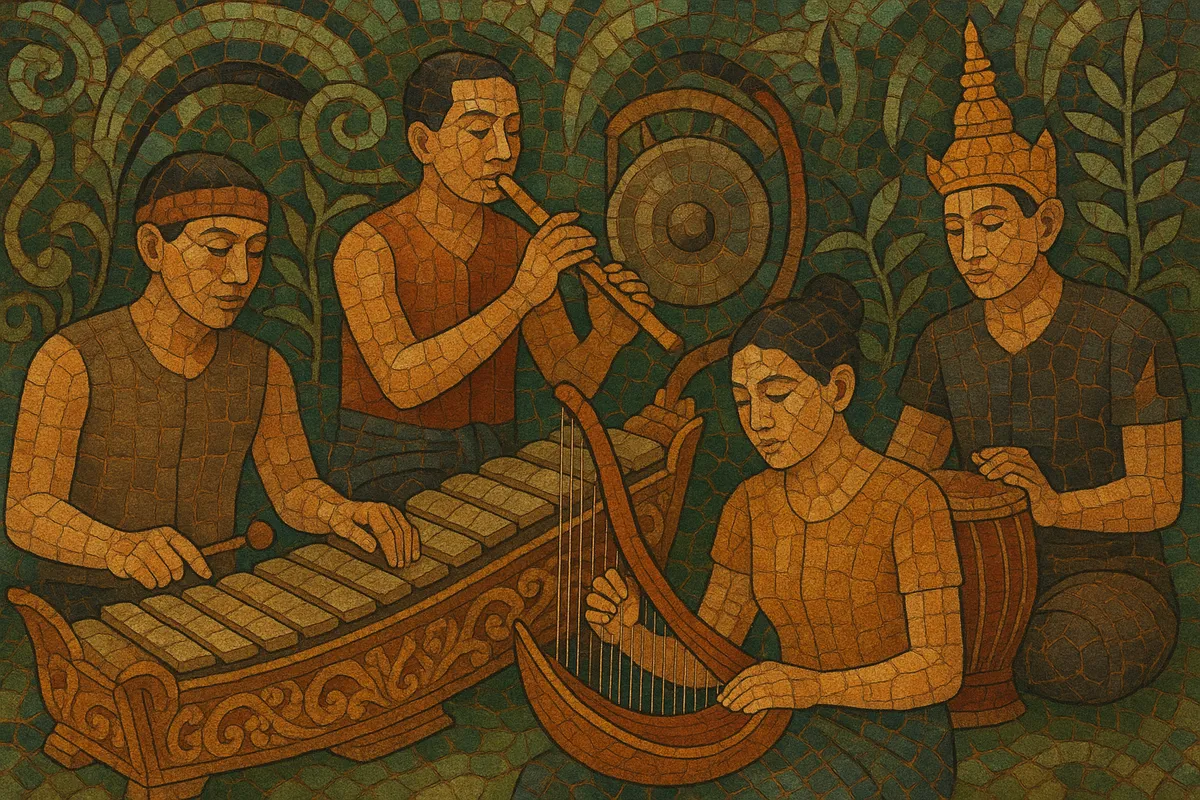Southeast Asian classical is a family of courtly and ritual art-music traditions from mainland and island Southeast Asia, encompassing gong–chime ensembles such as Javanese/Balinese gamelan (Indonesia), piphat (Thailand), pinpeat (Cambodia), and hsaing waing (Myanmar), as well as Vietnamese imperial and chamber repertoires. These traditions privilege cyclical time, heterophonic textures, and modal systems tied to ceremonial, theatrical, and cosmological functions.
Characteristic sound worlds include bronze gongs, metallophones, and xylophones marking colotomic cycles; reeded oboes (pi/sralai), bamboo flutes, lutes and zithers (e.g., đàn tranh), and the Burmese arched harp (saung gauk); double-headed drums (kendang/thon–rammana) articulating form; and rich layers of elaboration around a skeletal melody. Tuning is non-tempered and culturally specific (e.g., sléndro and pélog in Java/Bali; equidistant heptatonic systems in much of mainland Southeast Asia). The music accompanies court ritual, dance-drama, shadow puppetry, and temple observances, yet also thrives today in conservatories, cultural troupes, and contemporary composition.
Bronze gong cultures and ceremonial music predate written records in Southeast Asia, but between the 1200s and 1500s, court polities such as Majapahit (Java), Ayutthaya (Thailand), Angkor (Cambodia), and Burmese dynasties consolidated distinct court ensembles. Indic (Hindu–Buddhist) aesthetics, Chinese court/ritual models, and later Islamic courtly culture informed concepts of cosmology, modality, and ceremony. By this time, gong–chime orchestras, fixed-pitch metallophones, and reed–drum leadership had become defining features.
Island Southeast Asia developed Javanese and Balinese gamelan with sléndro/pélog tunings, colotomic cycles, and forms such as gendhing (with merong/inggah sections). Mainland traditions codified piphat (Thailand) and pinpeat (Cambodia), both featuring oboe (pi/sralai), xylophones (ranat/roneat), gong-circles (khong wong/kong vong), and stratified heterophony. Myanmar’s hsaing waing centered on drum- and gong-circles (pat waing/kye waing), while Vietnam maintained imperial nhã nhạc alongside elegant chamber traditions with zithers, fiddles, and flutes.
From the 19th to mid-20th centuries, colonial disruptions and political upheavals challenged court institutions. Some traditions declined (notably in Cambodia during the Khmer Rouge), yet many survived through temple contexts, master–apprentice lineages, and later state-sponsored conservatories. Recording technology, ethnomusicology, and UNESCO heritage initiatives (e.g., Balinese gamelan gong kebyar, Cambodian Royal Ballet, Vietnamese Nhã nhạc) aided transmission and revival.
Since the late 20th century, Southeast Asian classical musics have been taught in universities worldwide and have influenced global composers and genres (e.g., Western minimalism, ambient, world fusion). Today, they continue to serve ritual and theatrical functions at home, while also inspiring new composition, intercultural collaborations, and contemporary stage works.
Decide on a regional model: gamelan (Java/Bali), piphat/pinpeat (Thailand/Cambodia), hsaing waing (Myanmar), or Vietnamese court/chamber ensemble. Select the culturally appropriate tuning/mode (e.g., sléndro or pélog in Java/Bali; equidistant heptatonic and lai/modal families in Thailand/Cambodia; Burmese thachin gyi; Vietnamese điệu and hơi).
Design a colotomic cycle (gongan) with large gongs marking phrase ends and smaller gongs/metal idiophones articulating inner divisions. Compose a core or skeletal melody (balungan-like) that traces modal contours and cadence tones (e.g., seleh in Java). Plan formal sections (e.g., merong/inggah; sam chan > song chan pacing in mainland styles) and dynamic arcs.
Assign elaborating parts to metallophones/xylophones and gong-chimes that weave ornamental variations around the skeleton, maintaining heterophony rather than strict harmony. Use idiomatic figurations: cengkok and sekaran (Java/Bali), fast ranat/roneat figuration (Thailand/Cambodia), and pat waing drum–cue-driven figurations (Myanmar). Avoid Western functional harmony; emphasize modal voice-leading and timbral counterpoint.
Let drums lead tempo, transitions, and dance/theatre cues (kendang in Java/Bali; thon–rammana in Thailand; pat waing in Myanmar). Employ cyclical grooves that breathe with the form, allowing rubato introductions (buka/pathetan) when appropriate before settling into a steady pulse.
When adding voices, use syllabic, ornamented lines that mirror instrumental modal contours. Fit text to ritual/theatrical context (court praise, mythic narratives, dance-drama scenes) and observe diction and poetic meters native to the tradition.
Balance bronze/wood idiophones with reedy oboes or flutes and selective use of strings/harp/zither depending on the idiom. Preserve distinct timbral layers (low gong resonance, mid-register metallophones, bright mallet lines, reedy lead) to articulate depth and hierarchy.


